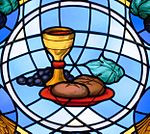
Back استحالة (مسيحية) Arabic Transsubstanciació Catalan Transsubstanciace Czech Trawsylweddiad Welsh Transsubstantiation Danish Transsubstantiation German Μετουσίωσις Greek Transsubstancigo Esperanto Transubstanciación Spanish Transsubstantsiatsioon Estonian
| Part of a series on the |
| Eucharist |
|---|
 |

Transubstantiation (Latin: transubstantiatio; Greek: μετουσίωσις metousiosis) is, according to the teaching of the Catholic Church, "the change of the whole substance of bread into the substance of the Body of Christ and of the whole substance of wine into the substance of the Blood of Christ".[1][2] This change is brought about in the eucharistic prayer through the efficacy of the word of Christ and by the action of the Holy Spirit.[3] However, "the outward characteristics of bread and wine, that is the 'eucharistic species', remain unaltered".[1] In this teaching, the notions of "substance" and "transubstantiation" are not linked with any particular theory of metaphysics.[4][5]
The Roman Catholic Church teaches that, in the Eucharistic offering, bread and wine are changed into the body and blood of Christ.[6][7] The affirmation of this doctrine on the real presence of Christ in the Eucharist was expressed, using the word "transubstantiate", by the Fourth Council of the Lateran in 1215.[8][9] It was later challenged by various 14th-century reformers, John Wycliffe in particular.[10]
The manner in which the change occurs, the Roman Catholic Church teaches, is a mystery: "The signs of bread and wine become, in a way surpassing understanding, the Body and Blood of Christ."[11] In Lutheranism, the terminology used regarding the real presence is the doctrine of the sacramental union, while in Anglicanism, the precise terminology to be used to refer to the nature of the Eucharist has a contentious interpretation: "bread and cup" or "Body and Blood"; "set before" or "offer"; "objective change" or "new significance".[12][13]
In the Greek Orthodox Church, the doctrine has been discussed under the term of metousiosis, coined as a direct loan-translation of transubstantiatio in the 17th century. In Eastern Orthodoxy in general, the Sacred Mystery (Sacrament) of the Eucharist is more commonly discussed using alternative terms such as "trans-elementation" (μεταστοιχείωσις, metastoicheiosis), "re-ordination" (μεταρρύθμισις, metarrhythmisis), or simply "change" (μεταβολή, metabole).
- ^ a b "Compendium of the Catechism of the Catholic Church". vatican.va.
- ^ "The Eucharist: What is the Eucharist?". www.usccb.org. Retrieved March 17, 2023.
- ^ "Liturgy of the Eucharist: Eucharistic Prayer". www.usccb.org. Retrieved March 17, 2023.
- ^ McNamara, Edward (19 April 2016). "Liturgy Q & A: On Transubstantiation". www.zenit.org. Retrieved March 17, 2023.
- ^ "Liturgy Q & A: On Transubstantiation". Zenit. April 19, 2016.
- ^ Fay, William (2001). "The Real Presence of Jesus Christ in the Sacrament of the Eucharist: Basic Questions and Answers". United States Conference of Catholic Bishops. Retrieved 13 December 2015.
the Catholic Church professes that, in the celebration of the Eucharist, bread and wine become the Body and Blood of Jesus Christ through the power of the Holy Ghost and the instrumentality of the priest.
- ^ Wilfried Apfalter, "Science, Law, and Transubstantiation", Theology and Science 22:1 (2024) 172-183.
- ^ "Internet History Sourcebooks Project". sourcebooks.fordham.edu.
- ^ "Lateran Council | Roman Catholicism". Encyclopedia Britannica.
- ^ Hillebrand, Hans J., ed. (2005). "Transubstantiation". The Oxford Encyclopedia of the Reformation. Oxford University Press. ISBN 978-0-19-506493-3. Retrieved 2017-05-30.
- ^ Cite error: The named reference
:0was invoked but never defined (see the help page). - ^ Voigt, A. G. (1917). Biblical Dogmatics. Press of Lutheran Board of Publication. p. 215.
- ^ Bradshaw, Paul F. (2012). The Eucharistic liturgies : their evolution and interpretation. Maxwell E. Johnson. Collegeville, Minn. ISBN 978-0-8146-6266-3. OCLC 957998003.
The Catholic Mass expects God to work a transformation, a change of the elements of bread and wine into the very presence of Christ. The Anglican prayers do not demand this objective change in the elements: they ask merely that the bread and wine should now take on new significance for us, as symbols of His Body and Blood. In fact, the Anglican formulae will bear interpretation either way. This is a deliberate policy, and part of the genius of Anglicanism, its ability to accommodate contradictory doctrines under the same outward form of words.
{{cite book}}: CS1 maint: location missing publisher (link)
© MMXXIII Rich X Search. We shall prevail. All rights reserved. Rich X Search